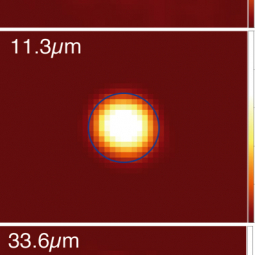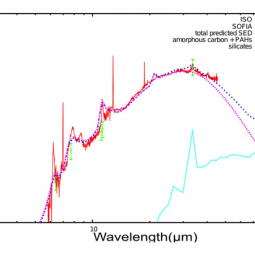The planetary nebula BD+30 3639 was imaged by SOFIA using FORCAST (Faint Object InfraRed Camera for the SOFIA Telescope; P.I. T. Herter, Cornell University) at wavelengths of 6.4, 7.7, 11.1, 11.3, and 33.6 microns. BD+30 3639 (also known as PN G064.7+05.0) is located at a distance of 1.2 kiloparsecs.
Oxygen (O) is about a factor of two more cosmically abundant than carbon (C), so all stars form from material that is O-rich. The cores of some stars become C-rich through the process of nucleosynthesis as they evolve. Many Asymptotic Giant Branch (AGB) stars are observed to have more carbon than oxygen in their photospheres and envelopes. This observation is consistent with the dredge-up of material from deep within the star. Such so-called carbon stars are understood to be the primary source of carbon in the Universe. A few other AGB stars, including BD+30 3639, are referred to as “dual-chemistry” systems because their spectra show evidence of both O-rich and C-rich material.
Two models make contrary, testable predictions about the respective locations of O-rich versus C-rich material in dual-chemistry envelopes. One model posits that O-rich material is present in a pre-existing stable disk around a few C-rich central stars. This hypothesis predicts that, in those rare systems, O-rich material will be entrained in, and thus co-located with, ongoing C-rich mass loss. An alternate model suggests that thermal pulsations in AGB stars can stir and mix inner and outer layers, dredging up different elements from their cores into their envelopes at different times. This hypothesis predicts that O-rich and C-rich material would enter the expanding envelopes at different epochs and be found at different radii. In this scenario, dual-chemistry cases would be rare examples of systems observed during astronomically short intervals of transition.
Analysis of the SOFIA/FORCAST images shows that BD+30 3639’s O-rich material is distributed in a shell in the outer parts of the nebula, whereas the C-rich material is located in the inner parts of the nebula, favoring the second of the two models. These observations, combined with a radiative transfer model of the envelope, suggest substantial carbon dredge-up occurred as recently as 1000 years ago with an amplitude consistent with a final thermal pulse before the star evolves out of the AGB life stage and after much of the original oxygen layers have been dispersed. Thus, we may be witnessing the transition of an O-rich object into a C-rich object.
Detailed information can be found in the paper by Guzman-Ramirez et al. 2015 , Monthly Notices of the Royal Astronomical Society, 451, 1. The MNRAS paper was highlighted in a New Scientist article titled: “Stars throw out a lifetime's waste carbon in just 1000 years” .

